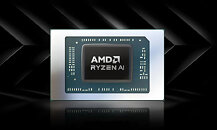T0@st
News Editor
- Joined
- Mar 7, 2023
- Messages
- 3,328 (3.84/day)
- Location
- South East, UK
| System Name | The TPU Typewriter |
|---|---|
| Processor | AMD Ryzen 5 5600 (non-X) |
| Motherboard | GIGABYTE B550M DS3H Micro ATX |
| Cooling | DeepCool AS500 |
| Memory | Kingston Fury Renegade RGB 32 GB (2 x 16 GB) DDR4-3600 CL16 |
| Video Card(s) | PowerColor Radeon RX 7800 XT 16 GB Hellhound OC |
| Storage | Samsung 980 Pro 1 TB M.2-2280 PCIe 4.0 X4 NVME SSD |
| Display(s) | Lenovo Legion Y27q-20 27" QHD IPS monitor |
| Case | GameMax Spark M-ATX (re-badged Jonsbo D30) |
| Audio Device(s) | FiiO K7 Desktop DAC/Amp + Philips Fidelio X3 headphones, or ARTTI T10 Planar IEMs |
| Power Supply | ADATA XPG CORE Reactor 650 W 80+ Gold ATX |
| Mouse | Roccat Kone Pro Air |
| Keyboard | Cooler Master MasterKeys Pro L |
| Software | Windows 10 64-bit Home Edition |
The "Medusa" or "Medusa Point" codename started to appear online over the past couple of months. These mysterious AMD projects were linked to next-generation "Zen 6" Ryzen desktop and mobile processor families (respectively). Initially, insiders reckoned that Team Red had selected an RDNA 4-based graphics solution for integration their futuristic new-gen laptop APU design. Two days ago, Golden Pig Upgrade weighed in with a different theory—the veteran leaker believes that provisions have regressed on the "Medusa Point" iGPU front.
Previous reports have suggested that the "Medusa Point" processor's iGPU aspect will utilize up to 16 compute units (CU), based on a theorized count of eight workgroup processors (WGPs) from leaked imagery. The latest insider tip points to the utilization of a non-specific "RDNA 3.x" branch, instead of conjectured RDNA 4 graphics technology. Industry watchdogs hold the belief that AMD will be sticking with RDNA 3.5 for a while—as featured on their current-gen "Zen 5" mobile-oriented Strix Point, Strix Halo and Krackan Point chips. As pointed out by Notebookcheck, Team Red leadership disclosed that RDNA 4 is exclusive to discrete card families (for the time being). RDNA 3.5-equipped APUs have—so far—received a warm welcome; AMD engineers could be reserving development resources for a distant future project.



View at TechPowerUp Main Site | Source
Previous reports have suggested that the "Medusa Point" processor's iGPU aspect will utilize up to 16 compute units (CU), based on a theorized count of eight workgroup processors (WGPs) from leaked imagery. The latest insider tip points to the utilization of a non-specific "RDNA 3.x" branch, instead of conjectured RDNA 4 graphics technology. Industry watchdogs hold the belief that AMD will be sticking with RDNA 3.5 for a while—as featured on their current-gen "Zen 5" mobile-oriented Strix Point, Strix Halo and Krackan Point chips. As pointed out by Notebookcheck, Team Red leadership disclosed that RDNA 4 is exclusive to discrete card families (for the time being). RDNA 3.5-equipped APUs have—so far—received a warm welcome; AMD engineers could be reserving development resources for a distant future project.



View at TechPowerUp Main Site | Source





